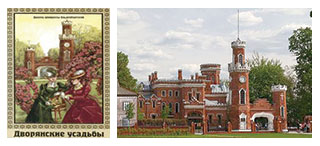Cultural heritage trade mark application rejected
24 August 2017Ramon Confectionary, a famous entity in Russia, filed trade mark application number 2013705310 in respect of goods in class 30 (pictured below).
 The figurative trade mark application carries an inscription for those who do not know: "Princess Oldenburg's Palace" and the words "Nobility Mansion" below the image.
The figurative trade mark application carries an inscription for those who do not know: "Princess Oldenburg's Palace" and the words "Nobility Mansion" below the image.
The application was rejected, the reason being that the word element "Princess Oldenburg's Palace" and the figurative element of the claimed designation reproduces a fragment of the Oldenburg's Palace, a mansion of late nineteenth century in a small Ramon town in the vicinity of the city of Voronezh in central Russia. Indeed, this is a mirror image of the fragment of the photographic picture.
The mansion is an architectural monument and an object of cultural heritage of the Russian Federation listed under number 3600268000 so that registration of the claimed designation as a means of individualisation of the applicant's goods claimed in the trade mark application would contradict the public interest.
The applicant did not agree with the reasoning of the patent office. He argued that the picture of the ladies against the background of the mysterious mansion creates a most favourable impression on the viewer. It elicits thoughts of mystique, of some secret. He added that the artistic part of the claimed designation is represented by a fragment of a painting authored by Oksana Andreeva, a painter who drew the picture to order of the applicant. The contract with the painter had been submitted earlier by the applicant.
He also argued that the claimed designation is a realisation of the creative artistic idea and not an accurate photographic reproduction of the architectural object existing in reality. The picture is the result of intellectual efforts of the painter. He stressed the fact that the image of the towers in the background does not dominate in the designation and the attention of the viewer is concentrated on the two ladies shown in the forefront. Those two ladies sitting in the garden are the key elements in the claimed designation.
The figurative element in the claimed designation is semantically supported by the word element "Nobility Mansion". The image of the towers of the castle implies mystery and makes the consumer think where those ladies came from.
The board of the Chamber of Patent Disputes was not convinced by the applicant's arguments and pointed out that one of the conspicuous elements in the claimed designation is the figurative element which is a fragment of castle with towers. The word element "Princess Oldenburg's Palace" has little importance in the claimed designation. It occupies an insignificant place in the designation and can hardly be read by the consumer. Even though it attracts less attention considering the importance of the figurative elements it nevertheless emphasises the perception of the designation as a whole.
The palace of the Oldenburg family has the status of federal cultural heritage under number 3600268000.
The building complex of the Oldenburg family is a coherent monument of landscape and architecture; it is the only one in central Russia whose owners were akin to the Emperor's family.
The Chamber of Patent Disputes has every reason to believe that Oldenburg's Palace complex is a cultural heritage of the Russian people and is treasured as a special cultural value of the Russian Federation.
Article 36 of Federal law of 1996 "The Museums of the Russian Federation" provides that production of printed products, souvenirs and other large-scale products and consumer goods with the use of images of museum exhibits and museum collections, museum buildings, objects located on their territory as well as the use of their names and symbols shall be made on permission of the museum administration.
The documents on file do not contain such permission in the name of the applicant. Hence the registration of the trade mark was finally rejected.
It should be noted however that the above cultural inheritance is not known to each and every person in Russia. The applicant himself helped the examiner to reject his application by making an inscription on the claimed designation: "Princess Oldenburg's Palace." He directed the examiner where to look for a citation which the examiner easily did. The chances are the applicant would have easily obtained registration without that word element. This however would not have guaranteed his immunity against an interested person who would have been able to cancel the trade mark if it interfered with his business.










